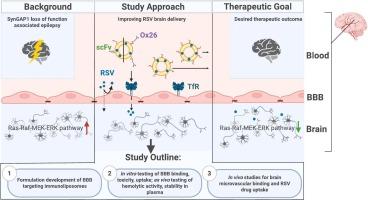免疫脂质体-治疗syngap1相关癫痫的新选择
IF 4.3
2区 医学
Q1 PHARMACOLOGY & PHARMACY
European Journal of Pharmaceutics and Biopharmaceutics
Pub Date : 2025-06-19
DOI:10.1016/j.ejpb.2025.114799
引用次数: 0
摘要
血脑屏障(BBB)阻碍大多数药物进入大脑的吸收。因此,生理上必需的活性过程,如受体介导的胞吞作用,已成为药物运输的热门靶点。其中一种受体是在血脑屏障高度表达的转铁蛋白受体1 (TfR)。靶向TfR的免疫脂体装载瑞舒伐他汀以改善syngap1相关癫痫的治疗。使用瑞舒伐他汀的理由是基于其下调Ras-Raf-MEK-ERK通路的功能,该通路在syngap1相关疾病患者的兴奋性神经元中上调。然而,瑞舒伐他汀显示血脑屏障通透性差。因此,制备了以抗tfr抗体Ox26及其单链可变片段(scFv)修饰的免疫脂质体,并对其进行了表征。可重复性制备,尺寸约125 nm,无溶血活性,在血浆中表现出2 h的胶体稳定性。它们表现出内皮细胞的高摄取,在天然配体转铁蛋白的存在下没有改变。在体内应用荧光标记的免疫脂质体显示出较长的血浆半衰期和在脑毛细血管中的积累。与未修饰的脂质体相比,Ox26-和scfv -免疫脂质体显示瑞舒伐他汀向脑组织的转移改善了2.8倍和2.5倍,表明血脑屏障成功通过。本文章由计算机程序翻译,如有差异,请以英文原文为准。

Immunoliposomes – a new therapeutic option to treat SynGAP1-associated epilepsy
The blood–brain barrier (BBB) hinders the uptake of most drugs into the brain. Thus, active processes, physiologically necessary for nutrient uptake, like receptor-mediated transcytosis have become popular targets for drug transport. One such receptor is the transferrin receptor 1 (TfR), being highly expressed at the BBB. Immunoliposomes targeting the TfR were loaded with rosuvastatin to improve the therapy of SynGAP1-associated epilepsy. The rational of using rosuvastatin is based on its function downregulating the Ras-Raf-MEK-ERK pathway, which is upregulated in excitatory neurons in patients with SynGAP1-related disorders. However, rosuvastatin shows poor BBB permeability. Therefore, immunoliposomes decorated with anti-TfR antibody Ox26 and its single-chain variable fragment (scFv) were prepared and characterized. Immunoliposomes could be prepared reproducibly with a size of about 125 nm, were not hemolytically active and showed colloidal stability in plasma for 2 h. They exhibited a high uptake into endothelial cells which was not altered in presence of the natural ligand transferrin. In vivo application of fluorescently labeled immunoliposomes demonstrated a long plasma half-life and accumulation in brain capillaries. In comparison to unmodified liposomes, Ox26- and scFv-immunoliposomes showed a 2.8- and 2.5-fold improved transfer of rosuvastatin into brain tissue, suggesting successful passage of the BBB.
求助全文
通过发布文献求助,成功后即可免费获取论文全文。
去求助
来源期刊
CiteScore
8.80
自引率
4.10%
发文量
211
审稿时长
36 days
期刊介绍:
The European Journal of Pharmaceutics and Biopharmaceutics provides a medium for the publication of novel, innovative and hypothesis-driven research from the areas of Pharmaceutics and Biopharmaceutics.
Topics covered include for example:
Design and development of drug delivery systems for pharmaceuticals and biopharmaceuticals (small molecules, proteins, nucleic acids)
Aspects of manufacturing process design
Biomedical aspects of drug product design
Strategies and formulations for controlled drug transport across biological barriers
Physicochemical aspects of drug product development
Novel excipients for drug product design
Drug delivery and controlled release systems for systemic and local applications
Nanomaterials for therapeutic and diagnostic purposes
Advanced therapy medicinal products
Medical devices supporting a distinct pharmacological effect.

 求助内容:
求助内容: 应助结果提醒方式:
应助结果提醒方式:


